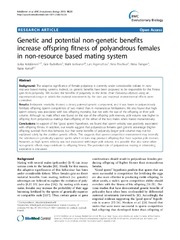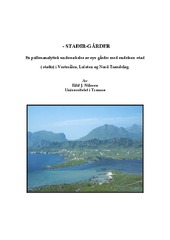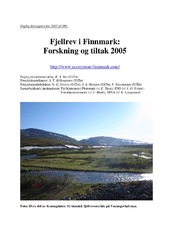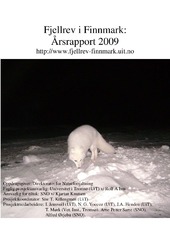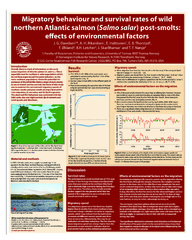Artikler, rapporter og annet (arktisk og marin biologi): Nye registreringer
Viser treff 1601-1620 av 1643
-
Genetic and potential non-genetic benefits increase offspring fitness of polyandrous females in non-resource based mating system
(Journal article; Tidsskriftartikkel; Peer reviewed, 2010) -
Experimental studies of reproduction and feeding for two Arctic-dwelling Calanus species exposed to crude oil
(Journal article; Tidsskriftartikkel; Peer reviewed, 2010-09-30)Copepods of the genus Calanus are keystone species in the transfer of energy from lower to higher trophic levels of the Arctic/sub-Arctic food web. We performed experimental tests on the reproduction and feeding of Calanus spp. exposed to the water-soluble fraction (WSF) of crude oil. Fecal pellet and egg production were examined for females of C. glacialis exposed to WSF (16 EPA) concentrations of ... -
Screening for antibacterial and antifungal activities in marine benthic invertebrates from northern Norway
(Journal article; Tidsskriftartikkel; Peer reviewed, 2008-06-18)Benthic marine invertebrates collected from sub-Arctic regions of northern Norway, were found to be a promising source of novel bioactive compounds against human and fish pathogenic bacteria and fungi. Lyophilized material from seven species of ascidians, six sponges and one soft alcyonid coral were extracted with 60% acidified acetonitrile (ACN). After separation into an ACN-rich phase (ACN extract) ... -
Farming cod: Putting the pressure on, and turning up the heat?
(Journal article; Tidsskriftartikkel, 2010) -
You are what you eat: Following fats through food chains
(Journal article; Tidsskriftartikkel, 2010) -
Staðir-gårder : en pollenanalytisk undersøkelse av syv gårder med endelsen –stad (-staðir) i Vesterålen, Lofoten og Nord-Trøndelag
(Research report; Forskningsrapport, 1996)Ti pollendiagram fra syv lokaliteter presenteres. Lokalitetene er gårder eller tidligere gårder med endelsen –stad eller -staðir (gammel flertallsform). Gårdene er i kommunene Bø, Hadsel og Vestvågøy i Nordland fylke, og Namdalseid kommune i Nord-Trøndelag fylke. <br>Undersøkelsene er en del av prosjektet ” ..-stadirgårder og pollenanalyse” (gårder med endelsen -stadir og pollenanalyse). Formål ... -
Fjellrev i Finnmark : forskning og tiltak 2005
(Research report; Forskningsrapport, 2005) -
Fjellrev i Finnmark : forskning og tiltak 2004
(Research report; Forskningsrapport, 2004) -
Fjellrev i Finnmark: Årsrapport 2009
(Research report; Forskningsrapport, 2009) -
Fjellrev i Finnmark : årsrapport for 2008
(Research report; Forskningsrapport, 2008) -
Prosjekt ”Fjellrev i Finnmark” : rapport for perioden 2004-2007
(Research report; Forskningsrapport, 2007) -
Fjellrev i Finnmark : forskning og tiltak 2006
(Research report; Forskningsrapport, 2006) -
Migratory behaviour and survival rates of wild northern Atlantic salmon Salmo salar post-smolts: effects of environmental factors
(Conference object; Konferansebidrag, 2009-09-14) -
Migratory behaviour and survival rates of wild northern Atlantic salmon (Salmo salar) post-smolts: effects of environmental factors
(Journal article; Tidsskriftartikkel; Peer reviewed, 2009-12-03)To study smolt behaviour and survival of a northern Atlantic salmon (Salmo salar) population during river descent, sea entry and fjord migration, 120 wild S. salar were tagged with acoustic tags and registered at four automatic listening station arrays in the mouth of the North Norwegian River Alta and throughout the Alta Fjord. An estimated 75% of the post-smolts survived from the river mouth, ... -
Cultural eutrophication: perspectives and prospects
(Chapter; Bokkapittel, 2005-01-06)History of cultural eutrophication. Cultural eutrophication is old as Homo sapiens. In particular after the introduction of agriculture and larger settlements eutrophication has been mans faithful companion. During the pre-agricultural hunting and picking stage only probably a couple million humans inhabited the world and cultural eutrophication was negligible. The 3 orders of magnitude ... -
Eutrophication, primary production and vertical export
(Chapter; Bokkapittel, 2005-01-06)Introduction. The effects of global and local changes are most prominent at the land-sea margins where presently population growth is greatest. For example, the population of coastal counties of the USA has roughly doubled since 1960 (Eos, 1992). This gives rise to increased pressure on natural resources and a large number of disturbances to coastal regions. Presently, eutrophication of ... -
Drainage basin nutrient inputs and eutrophication: an integrated approach
(Book; Bok, 2005-01-06)Eutrophication is an increase in primary production due to increased nutrient supply and its consequences. In its widest sense eutrophication means any increase of nutrient availability that increases primary production. Frequently, however, eutrophication is understood exclusively as the consequence of nutrient input by anthropogenic activities. The primary consequence of eutrophication in aquatic ... -
Pelagic eutrophication in the Gulf of Riga
(Chapter; Bokkapittel, 2005-01-06)Quantitative estimates of the fluxes and dynamics in the nutrient load on marine environments, their distribution and channelling through the food web and the effect on the increase of new production, are fundamental and constitute a prerequisite for the planning of actions for water protection measures. The Gulf of Riga is no exception. The Gulf is a semi-enclosed part of the eastern Baltic ... -
Eutrophication of the East African Great Lakes
(Chapter; Bokkapittel, 2005-01-06)Several of the African Great Lakes are distinctive for their very long water residence time >100 years. Incoming nutrients will be retained within the lakes and recovery will be slow even if inputs are reduced. While changes in chemistry and plankton composition of Lake Malawi have not been extreme to date, strong eutrophication is already happening in Lake Victoria, where damage has reduced its ... -
Integrated approaches to drainage basin nutrient inputs and coastal eutrophication: an introduction
(Chapter; Bokkapittel, 2005-01-06)Ingress Eutrophication is an increase in primary production due to increased nutrient supply and its consequences. In its widest sense eutrophication means any increase of nutrient availability that increases primary production. Frequently, however, eutrophication is understood exclusively as the consequence of nutrient input by anthropogenic activities. The primary consequence of ...


 English
English norsk
norsk